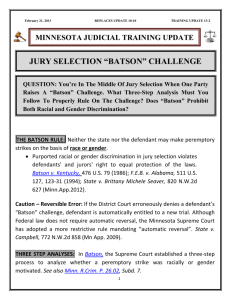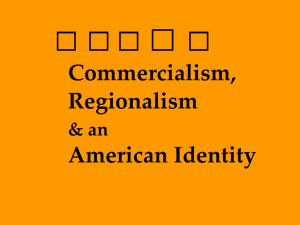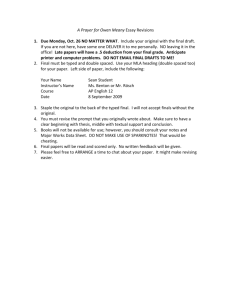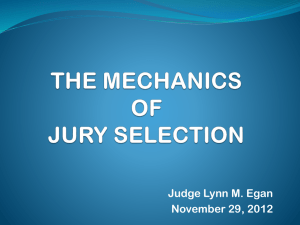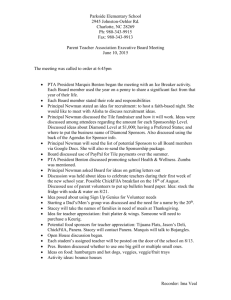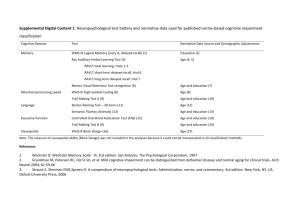No. 42,121-KA COURT OF APPEAL SECOND CIRCUIT STATE OF
advertisement
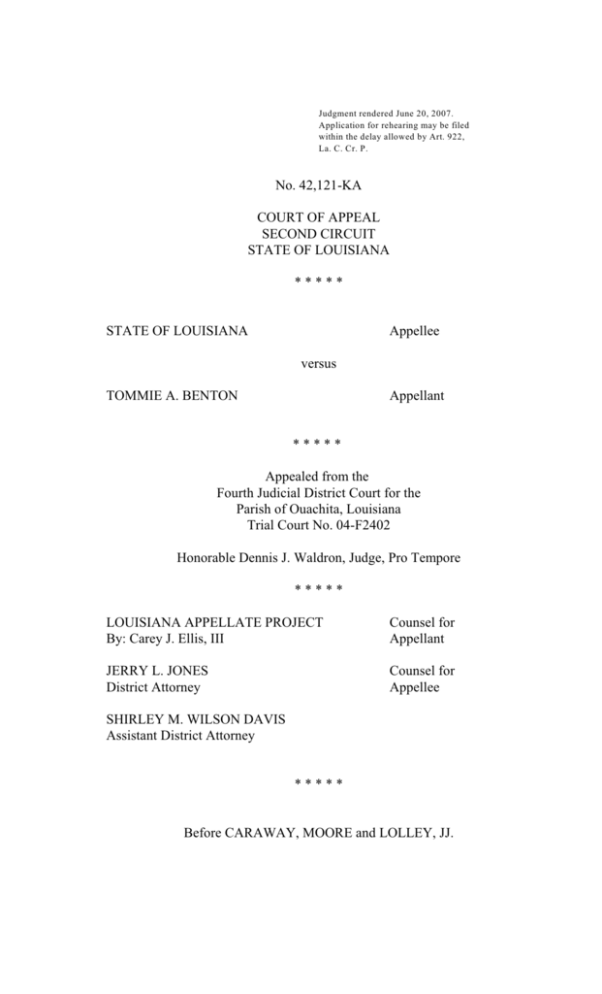
Judgment rendered June 20, 2007. Application for rehearing may be filed within the delay allowed by Art. 922, La. C. Cr. P. No. 42,121-KA COURT OF APPEAL SECOND CIRCUIT STATE OF LOUISIANA ***** STATE OF LOUISIANA Appellee versus TOMMIE A. BENTON Appellant ***** Appealed from the Fourth Judicial District Court for the Parish of Ouachita, Louisiana Trial Court No. 04-F2402 Honorable Dennis J. Waldron, Judge, Pro Tempore ***** LOUISIANA APPELLATE PROJECT By: Carey J. Ellis, III Counsel for Appellant JERRY L. JONES District Attorney Counsel for Appellee SHIRLEY M. WILSON DAVIS Assistant District Attorney ***** Before CARAWAY, MOORE and LOLLEY, JJ. MOORE, J. Tommie Benton was charged by bill of information with simple burglary, La. R.S. 14:62. After a jury found him guilty as charged, the district court adjudicated him a second felony offender and sentenced him to six years at hard labor. Benton now appeals, urging insufficiency of the evidence to convict and irregularities in the jury selection process. For the reasons expressed, we affirm. Factual Background Ray Anding Jr., a building contractor, was building four houses on the south side of Monroe in the fall of 2004. He experienced recurring incidents with theft of tools and materials from the house at 1816 Hickory Street, while the walls were up but no doors or windows were yet in place. He reported the thefts but police were unable to develop any leads. Anding then installed two surveillance video cameras in the attic, aimed at the front and back windows. Early on October 6, one of these cameras captured the images of two men entering through the front window and then leaving, carrying a drill and some other tools. The video did not clearly capture the burglars’ faces, but one of the men was wearing a distinctive hat (Anding called it a “kangaroo hat”). The video also showed a Ford F-150 extended-cab pickup truck parked on the street. Anding brought the video to Monroe Police Detective Tommy Rhodes, who agreed to install a “VARDA” alarm in the house. Det. Rhodes described this as a thermal-sensing device which, when activated, sends a silent alarm directly on police radio frequency, skipping the switchboard and allowing for faster response. Early on the morning of October 10, the VARDA alarm went off. Officer Douglas Lambert was nearby and responded within 30 seconds. As he pulled up, his spotlight beamed on a black man exiting the house and walking toward a truck parked on the street. There was a set of muddy footprints going into and out of the house; the suspect was wearing a distinctive “kangaroo cap” but was empty-handed. Officer Lambert took him into custody without a struggle; the suspect identified himself as Tommie Benton. Officer Lambert drove him to the Police Department while the Lieutenant photographed the scene, including the Ford F-150 truck parked on the street. At the police station, Det. Rhodes advised Benton of his Miranda rights. Indicating that he understood, Benton signed a waiver and admitted that he had entered the building site “to retrieve plastic to cover a busted window” on his truck. The crime scene photos, however, did not show that any of the truck windows were broken, and no items of Anding’s were found in the vehicle. As noted, the state charged Benton by bill of information with simple burglary; a six-member jury found him guilty as charged.1 Citing Benton’s 1996 guilty plea to felony-grade illegal possession of stolen things, the state then charged him as a repeat offender. The court adjudicated him a second felony offender and subsequently sentenced him to six years at hard labor, the minimum sentence under La. R.S. 15:529.1 A(1)(a) and 14:62 B. 1 The court minutes and counsel’s opening remarks at voir dire show that Benton was also charged by separate bill of information (No. 04-F2275) with another simple burglary, of which he was acquitted. The instant record contains no other details of that alleged offense. 2 Discussion: Sufficiency of the Evidence By his first assignment of error, Benton urges the evidence was insufficient to convict him of simple burglary. He summarizes the state’s case, emphasizing (1) neither burglar’s face could be discerned from the October 6 surveillance video, (2) the kangaroo hat worn by Benton on the night of his arrest was only similar to that worn by one of the burglars on the surveillance video, (3) when arrested, Benton was not carrying any items stolen from the construction site, (4) he did not attempt to flee from Officer Lambert, and (5) his statement to Det. Rhodes expressed no intent to permanently deprive Anding of the piece of plastic he was seeking. While he concedes that he was present at the house on the morning of October 10, he argues that no burglary occurred on that date; he submits that somebody else, wearing a similar hat to his, must have committed the burglary captured on surveillance video four days earlier. The state responds that Benton obviously entered the house, as shown by the set of muddy footprints going in and out and by the fact that he was exiting the structure only seconds after the VARDA system was activated. Further, the similarity of the kangaroo hat and the F-150 truck on both occasions proved that Benton was indeed the perpetrator; finally, his statement to police supplied the necessary intent to commit a theft inside the unfinished house. The standard of appellate review is “whether, after viewing the evidence in the light most favorable to the prosecution, any rational trier of fact could have found the essential elements of the crime beyond a 3 reasonable doubt.” Jackson v. Virginia, 443 U.S. 307, 319, 99 S. Ct. 2781, 2789 (1979); State v. Tate, 2001-1658 (La. 5/20/03), 851 So. 2d 921, cert. denied, 541 U.S. 905, 124 S. Ct. 1604 (2004). This standard, now legislatively embodied in La. C. Cr. P. art. 821, does not provide the appellate court with a vehicle to substitute its own appreciation of the evidence for that of the fact finder. State v. Pigford, 2005-0477 (La. 2/22/06), 922 So. 2d 517. The trier of fact is charged to make a credibility evaluation and may, within the bounds of rationality, accept or reject the testimony of any witness; the reviewing court may impinge on that discretion only to the extent necessary to guarantee the fundamental due process of law. State v. Sosa, 2005-0213 (La. 1/19/06), 921 So. 2d 94. When circumstantial evidence is used to prove the offense, La. R.S. 15:438 requires that “assuming every fact to be proved that the evidence tends to prove, in order to convict, it must exclude every reasonable hypothesis of innocence.” Ultimately, all evidence – both direct and circumstantial – must be sufficient under Jackson v. Virginia to prove guilt beyond a reasonable doubt to a rational jury. State v. Robinson, 2002-1869 (La. 4/14/04), 874 So. 2d 66. Simple burglary is “the unauthorized entering of any dwelling, vehicle, watercraft, or other structure, movable or immovable, or any cemetery, with the intent to commit a felony or any theft therein[.]” La. R.S. 14:62 A. It is not necessary to prove an actual theft to establish a case of burglary. State v. Hall, 26,505 (La. App. 2 Cir. 12/7/94), 647 So. 2d 453; State v. Hooker, 623 So. 2d 178 (La. App. 2 Cir. 1993). 4 This record easily establishes that the owner, Anding, gave nobody permission to enter the unfinished structure overnight. Benton challenges the jury’s implicit findings that he actually entered the structure and had the intent to commit a theft therein. Although no witness saw Benton inside the house on the morning of October 10, the VARDA system had been activated, showing that somebody entered. Seconds, later Officer Lambert arrived to find Benton walking away from the house, and a single set of muddy footprints leading in and out of the open structure. These circumstances strongly suggest that Benton entered (and left) the house. More directly, according to Det. Rhodes, Benton admitted coming to the construction site and entering to take some plastic. On this record, a rational juror was entitled to accept Benton’s admission that he entered the structure. As for Benton’s intent, his statement to Det. Rhodes admits he was there to take plastic from the site for his broken truck window. A rational juror could interpret this as indicating an intent to deprive the owner of the plastic permanently, not just borrow it. Benton correctly shows that Lt. Harris could not recall if any windows on the F-150 were broken, and the photos do not appear to show any broken windows. However, a rational juror could easily discount this portion of the statement as a hasty and unconvincing effort to explain his presence at the job site, when in fact the real purpose was a theft which was thwarted only by the timely appearance of the police. The evidence was sufficient to prove Benton’s intent to commit a theft therein. The evidence is sufficient and this assignment of 5 error lacks merit. Peremptory Challenges of Prospective Jurors By his second assignment, Benton urges the state improperly struck prospective jurors on the basis of race. He shows that the defendant is an African American male, and the victim a white male; that the state used all six peremptory challenges to excuse one black male, one white male and four black females from the panel; that the defendant made a timely objection before the entire final panel was sworn; and the final panel was all white. Benton contends that these facts created a prima facie showing of racial discrimination under Batson v. Kentucky, 476 U.S. 79, 106 S. Ct. 1712 (1986). He submits that the state offered weak factual reasons for its first two peremptory challenges, of Mr. Roggerson and Ms. Bass, a suspicious age-based reason for another, Ms. Nobles, and no reasons at all (a “gut feeling”) for the other two, of Ms. Turner and Ms. Price. He concedes that the district court’s evaluation of discriminatory intent is due great deference. Hernandez v. New York, 500 U.S. 352, 111 S. Ct. 1859 (1991). He nevertheless concludes that the state’s reasons do not withstand Batson analysis and the case must be reversed. The state responds that Benton failed to make a prima facie showing of discrimination, as the state accepted two black venire members whom the defendant later challenged peremptorily. The state reiterates its factual bases for challenging Mr. Roggerson, Ms. Bass and Ms. Nobles; contends that it relied on “gut instincts” and voir dire interactions to excuse Ms. Turner; and that the challenge of Ms. Price was irrelevant because by that 6 time, six jurors and one alternate had already been selected. The state also notes that in response to a question by the court, the prosecutor expressly denied any discriminatory intent. Finally, the state cites the great discretion afforded the district court’s rulings on Batson objections. Hernandez v. New York, supra; State v. Coleman, 41,764 (La. App. 2 Cir. 1/24/07), 949 So. 2d 570. The state concludes there is no basis to disturb the ruling. An equal protection violation occurs if a party exercises a peremptory challenge to exclude a prospective juror on the basis of a person’s race. Batson v. Kentucky, supra. The familiar three-step Batson analysis was recently described in Rice v. Collins, 546 U.S. 333, 126 S. Ct. 969 (2006), as follows: A defendant’s Batson challenge to a peremptory strike requires a three-step inquiry. First, the trial court must determine whether the defendant has made a prima facie showing that the prosecutor exercised a peremptory challenge on the basis of race. Second, if the showing is made, the burden shifts to the prosecutor to present a race-neutral explanation for striking the juror in question. Although the prosecutor must present a comprehensible reason, the second step of this process does not demand an explanation that is persuasive, or even plausible; so long as the reason is not inherently discriminatory, it suffices. Third, the court must then determine whether the defendant has carried his burden of proving purposeful discrimination. This final step involves evaluating the persuasiveness of the justification proffered by the prosecutor, but the ultimate burden of persuasion regarding racial motivation rests with, and never shifts from, the opponent of the strike. 546 U.S. at ___, 126 S. Ct. at 973-974 (internal quotations and citations omitted). Louisiana has codified the ruling of Batson in La. C. Cr. P. art. 795, which provides in pertinent part: 7 C. No peremptory challenge made by the state or the defendant shall be based solely upon the race of the juror. If an objection is made that the state or defense has excluded a juror solely on the basis of race, and a prima facie case supporting that objection is made by the objecting party, the court may demand a satisfactory racially neutral reason for the exercise of the challenge, unless the court is satisfied that such reason is apparent from the voir dire examination of the juror. Such demand and disclosure, if required by the court, shall be made outside of the hearing of any juror or prospective juror. D. The court shall allow to stand each peremptory challenge exercised for a racially neutral reason either apparent from the examination or disclosed by counsel when required by the court. The provisions of Paragraph C and this Paragraph shall not apply when both the state and the defense have exercised a challenge against the same juror. E. The court shall allow to stand each peremptory challenge for which a satisfactory racially neutral reason is given. Those jurors who have been peremptorily challenged and for whom no satisfactory racially neutral reason is apparent or given may be ordered returned to the panel, or the court may take such other corrective action as it deems appropriate under the circumstances. The court shall make specific findings regarding each such challenge. The district court’s evaluations of discriminatory intent are afforded great deference and will not be reversed unless clearly wrong. Hernandez v. New York, supra; State v. Elie, 2005-1569 (La. 7/10/06), 936 So. 2d 791. The trial court is in a position to observe firsthand the demeanor of the attorneys and the venire members, the nuances of questions asked, the racial composition of the venire, and the general atmosphere of the voir dire that simply cannot be replicated from a cold transcript. State v. Juniors, 20032425 (La. 6/29/05), 915 So. 2d 291, cert. denied, ___ U.S. ___, 126 S. Ct. 1940 (2006). Once a prosecutor has offered a race-neutral explanation for the peremptory challenges and the trial court has ruled on the ultimate question of intentional discrimination, the preliminary issue of a prima facie 8 showing becomes moot. Hernandez v. New York, 500 U.S. at 359, 111 S. Ct. at 1866; State v. Wilson, 40,767 (La. App. 2 Cir. 8/23/06), p. 20, 938 So. 2d 1111, at 1126. The state initially contends that because it elected not to challenge two black prospective jurors, this undermined Benton’s showing of a prima facie case of discrimination. However, a single strike based upon race supports a Batson claim and requires reversal no matter how ably the state has justified its other strikes. Batson v. Kentucky, 476 U.S. at 95, 106 S. Ct. at 1722; State v. Elie, supra; State v. Wilson, supra. Moreover, because the court required the state to provide race-neutral reasons for five of its challenges, and ruled on the issue, the question of the prima facie showing is moot. Hernandez v. New York, supra; State v. Robinson, supra; State v. Wilson, supra. We therefore will review the record with respect to each challenged juror.2 The prosecutor stated that she challenged Mr. Roggerson because he served on two boards (labor union and Interstate highway development) on which Benton’s trial counsel also served as general counsel. The record supports this explanation. Familiarity with a party or an attorney in the case is a race-neutral basis for a peremptory challenge. State v. Baker, 34,973 (La. App. 2 Cir. 9/26/01), 796 So. 2d 145; State v. Mamon, 26,337 (La. 2 It would have been helpful had the court followed the procedure of Batson (and of Art. 795) by first requiring the defendant to state on the record the factual basis of the objection, then finding a prima facie showing, and only then requiring the state to offer a race-neutral explanation for the challenges. As the court noted in State v. Robinson, 874 So. 2d at 85 (fn. 10), “the trial judge may effectively collapse the first two stages of Batson and rule on the question of discriminatory intent without deciding the question of whether the defendant established a prima facie case of purposeful discrimination.” In the instant case, owing to the abridged procedure, the defendant made no comments about, or only pro forma denials of, the state’s explanations for its peremptory challenges. 9 App. 2 Cir. 12/16/94), 648 So. 2d 1347, writ denied, 95-0220 (La. 6/2/95), 654 So. 2d 1104. The prosecutor stated that she challenged Ms. Bass because her mother’s house had been burglarized several times, including once when family members were in the house, and she felt the police did not adequately investigate the matters. Defense counsel replied that Ms. Bass’s ill feelings toward burglars might actually operate in the state’s favor. However, potential ill-will against the police is a valid, race-neutral basis for a peremptory challenge. State v. Mamon, supra; State v. Jones, 00-162 (La. App. 5 Cir. 7/25/00), 767 So. 2d 862. The prosecutor stated that she challenged Ms. Nobles because she was elderly, appeared inattentive, and only nodded in response to questions. The record supports these observations; lack of attention to the proceedings constitutes a race-neutral basis for a peremptory challenge. State v. Ellis, 28,282 (La. App. 2 Cir. 6/26/96), 677 So. 2d 617, writ denied, 96-1991 (La. 2/21/97), 688 So. 2d 521; State v. Mamon, supra. The prosecutor stated that she could not really articulate her reasons for challenging Ms. Turner and Ms. Price, other than, “when you’re talking to these people, [you] get a feel for them,” and “that’s just my gut instinct.” A “gut feeling” may well include discriminatory feelings and, without more, is not a sufficient race-neutral basis for a peremptory challenge. Alex v. Rayne Concrete Serv., 2005-1457 (La. 1/26/07), p. 19, 951 So. 2d 138, at ___; State v. Ford, 26,422 (La. App. 2 Cir. 9/21/94), 643 So. 2d 293. However, Ms. Turner disclosed that, like Ms. Bass, her mother’s house had 10 been broken into “at the end of last year,” with the result that money and jewelry had been stolen and the whole house “trashed.” She denied that this would affect her ability to be an impartial juror, but being a recent crime victim is a race-neutral basis for a challenge. State v. Thornton, 36,757 (La. App. 2 Cir. 1/29/03), 836 So. 2d 1235, writ denied, 2003-0861 (La. 10/31/03), 857 So. 2d 474; State v. Burgess, 2004-121 (La. App. 3 Cir. 6/16/04), 876 So. 2d 263. The question is somewhat closer with Ms. Price. The cold record offers little guidance; at voir dire, in response to general questioning, she never volunteered an answer, and on four occasions when directly asked, she replied with a simple “yes” or “no.” After observing the proceedings, the district court may well have felt that this translated to lack of attention or responsiveness, a valid race-neutral explanation. State v. Ellis, supra. The court stated for the record that both prosecutor and defense counsel were African Americans, and the prosecutor confirmed that she was under no instructions to assure that the jury had any specific racial or gender makeup. In the totality of the circumstances, we cannot say the court’s decision to grant this peremptory challenge was an abuse of discretion. This assignment of error lacks merit. Conclusion In accordance with La. C. Cr. P. art. 920 (2), we have reviewed the entire record and find nothing we consider to be error patent. For these reasons, Tommie Benton’s conviction and sentence are affirmed. AFFIRMED. 11

